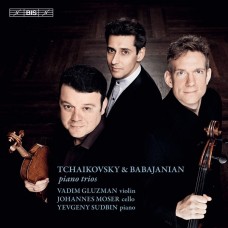|
柴可夫斯基 & 阿爾諾.巴巴哈年 & 阿弗列德.施尼特凱 / 鋼琴三重奏
瓦丁.葛魯茲曼 小提琴
約翰尼斯.莫瑟 大提琴
葉夫蓋尼.蘇德賓 鋼琴
在俄羅斯室內樂中, 有個相當特別的傳統圍繞著鋼琴三重奏而發展起來, 有幾位作曲家轉向這個音樂類別開始編寫"樂器演奏的安魂曲". 第一件作品是柴可夫斯基的A小調鋼琴三重奏, 作品50 "紀念一位偉大的藝術家 à la mémoired' un grand artiste". 從此之後拉赫曼尼諾夫, 阿倫斯基和蕭士塔高維契等作曲家也跟著寫. 在柴可夫斯基的三重奏中的"偉大的藝術家"指的是鋼琴家魯賓斯坦, 他選擇用三重奏類別的原因是他覺得一件用鋼琴獨奏的作品會不夠莊重, 而且用管弦樂伴奏則太過於盛大. 該作品有兩個樂章, (輓歌, Pezzoel egiaco)和一組變奏曲, 一開始是大提琴演奏動人的哀悼音樂, 這一段決定了整個第一樂章的音調. 在第二樂章的結尾, 這主題旋律會以激情的葬禮進行曲型式再度出現.
七十年之後, 當美國作曲家兼鋼琴家巴巴哈年(Babajanian, 1921-83)寫他的升F小調鋼琴三重奏時並未給予任何副標題, 但其規模壯觀與深廣度足以與柴可夫斯基的作品相比--尤其是第二樂章完全是輓歌的特質. 這三重奏是巴巴哈年最為人所知的作品, 雖然是以拉赫曼尼諾夫的浪漫曲風編寫, 但無論是曲調或旋律仍是根基於美國民謠音樂. 演奏這兩件作品的是葛魯茲曼與蘇德賓, 兩人都有俄羅斯根源, 加上大提琴家莫瑟. 三人在最後演奏的是蘇德賓改編施尼特凱簡短的探戈曲.
Vadim Gluzman
Johannes Moser
Yevgeny Sudbin
In Russian chamber music, a rather special tradition evolved around the piano trio, with a number of composers turning to the genre to write ‘instrumental requiems'. First out was Tchaikovsky with his Piano Trio in A minor, Op. 50, ‘a la memoire d'un grand artiste', and he was followed by composers such as Rachmaninov, Arensky and Shostakovich. In the case of Tchaikovsky's trio, the ‘grand artiste' was the pianist Nikolai Rubinstein, and Tchaikovsky chose the trio genre as he felt that a piece for solo piano would be too lightweight and one with orchestral accompaniment would be too showy. The work is in two movements, a Pezzo elegiaco (‘elegiac piece') and a set of variations, and it begins with the cello playing a moving lament which sets the tone for the entire first movement. The theme returns at the end of the second movement in the form of an impassioned funeral march.
Seventy years later, when the Armenian composer and pianist Arno Babajanian (1921—83) wrote his Piano Trio in F sharp minor, he didn't give it any subtitle, but there's a grandeur and breadth of scale which rivals Tchaikovsky's work – and the second movement is thoroughly elegiac in character. The trio is Babajanian's best-known work, composed in the Romantic style of Rachmaninov, but also rooted in Armenian folk music, melodically as well as rhythmically. Performing the two works are Vadim Gluzman and Yevgeny Sudbin, both with Russian roots, joined by cellist Johannes Moser, and the three close the disc with Sudbin's arrangement of a brief Tango by Alfred Schnittke.
Pyotr Ilyich Tchaikovsky (1840—93)
Piano Trio in A minor, Op. 50 48'20
a la memoire d'un grand artiste
1 ) I. Pezzo elegiaco 17'47
2—14 ) II. Tema con variazioni — Variazione Finale e Coda 30'24
Arno Babajanian (1921—83)
Piano Trio (1952) 21'30
15 ) I. Largo — Allegro espressivo 8'37
16 ) II. Andante 6'54
17 ) III. Allegro vivace 5'48
Alfred Schnittke (1934—98), arr. Sudbin
18 ) Tango from the opera Life with an Idiot (1992) 2'21
TT: 73'21 |
|



